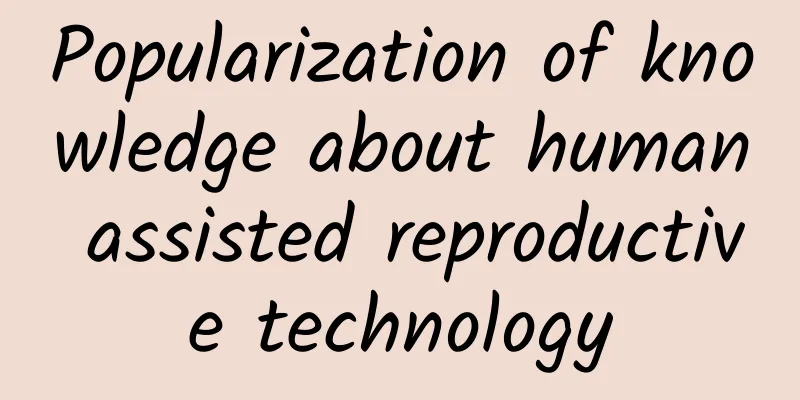Popularization of knowledge about human assisted reproductive technology

|
Children are the source of happiness for the family and the hope for the future. However, due to factors such as the postponement of marriage age, increased work pressure, and changes in living environment in recent years, tens of millions of couples in my country suffer from infertility every year. my country is now a country with a high infertility rate. However, most people know little about this technology. What is assisted reproductive technology? What specific technologies does assisted reproductive technology include? What is the significance of assisted reproductive technology? In order to solve everyone's doubts, this article briefly explains the relevant knowledge of human assisted reproductive technology. 1. What is assisted reproductive technology? Human assisted reproductive technology is a technology that uses medical technology and methods to artificially intervene in gametes, zygotes, and embryos to ultimately achieve conception. Human assisted reproductive technology includes artificial insemination technology and in vitro fertilization-embryo transfer and its various derivative technologies. 2.What specific technologies does assisted reproductive technology include? (1) Artificial insemination technology Artificial insemination technology is a method of artificially injecting optimized and screened semen into the female body to replace sexual intercourse to make her pregnant. According to the different sources of semen, it is divided into artificial insemination with husband's semen (AIH) and artificial insemination with donor sperm (AID). It is also the assisted reproductive technology with the highest clinical application rate. This technology has high economic practicality and is easy to operate. This technology was introduced at the end of the 18th century. It was first applied to mammals. It was first applied to humans in 1870 and successfully made a human pregnant in 1884. Artificial insemination with husband's semen is mainly aimed at men with mild oligoasthenozoospermia, abnormal semen liquefaction, female cervical factors, sexual intercourse disorders caused by sexual dysfunction or reproductive tract malformations, ovulation disorders, infertility after simple drug treatment (such as PCOS), endometriosis, immune infertility, unexplained infertility, etc. Artificial insemination with donor sperm is mainly aimed at men with genetic diseases or azoospermia. (2) In vitro fertilization-embryo transfer technology This technology refers to the process of taking eggs from a woman's body, culturing them in a vessel, adding sperm that has been treated with the technology, and continuing to culture the eggs after fertilization. When the eggs are formed into early embryos, they are transplanted into the uterine cavity for implantation and develop into a fetus until delivery. In 1978, British doctors used this technology to help a couple successfully give birth to the first test-tube baby, which meant that human assisted reproductive technology had made a qualitative leap. Ten years later, my country also successfully gave birth to a test-tube baby with this technology. Clinically, there are three generations of test-tube babies: first-generation test-tube babies, second-generation test-tube babies, and third-generation test-tube babies. The first generation of test tube babies is mainly targeted at: 1) Gamete transport disorders caused by various factors on the female side (such as fallopian tube factors), endometriosis, ovulation disorders, oligoasthenozoospermia on the male side, unexplained infertility, etc. In recent years, this technology has been mastered by hundreds of reproductive medical centers in my country and has a high success rate. The second generation of test-tube babies: It uses intracytoplasmic sperm injection technology. With the continuous development of micromanipulation technology, the clinical introduction of intracytoplasmic sperm insemination technology has provided new treatment options for patients with infertility due to male sperm problems. In 1992, Belgium successfully gave birth to a test-tube baby with this technology. Four years later, my country also successfully gave birth to a test-tube baby with this technology. The main targets are immune infertility, spermatogenesis disorders, irreversible obstructive azoospermia, severe oligoasthenozoospermia, in vitro fertilization failure, sperm acrosome abnormalities, etc. The sperm is taken out from the testicle or epididymis and given to the sperm intracytoplasmic insemination technology to achieve successful pregnancy. Third-generation test-tube babies: Genetic diseases have become one of the major diseases that threaten human health. Using prenatal diagnosis technology to prevent the birth of children with genetic diseases is currently the main way to reduce the occurrence of genetic diseases. Since the 1960s, amniocentesis and chorionic villus sampling have been routinely used in prenatal diagnosis, effectively reducing the birth of children with genetic diseases. Non-invasive prenatal diagnosis and preimplantation genetic diagnosis (PGD) refer to the use of medical means to detect genes/chromosomes on gametes or embryos, so that embryos can be further optimized. The scope of application of this technology: women with repeated implantation failures, repeated spontaneous abortions, advanced age, patients with single-gene genetic diseases, some chromosomal disease carriers, and elderly women with good ovarian reserves, etc., bring new hope for the birth of healthy offspring. In 1989, British scholars successfully applied this technology to clinical practice, creating a new era of prenatal diagnosis. Ten years later, my country completed the first preimplantation genetic screening/preimplantation genetic diagnosis. Since then, with the gradual promotion of technologies such as second-generation sequencing, high-throughput sequencing, comparative genomic hybridization, whole genome amplification, fluorescent PCR, and fluorescent in situ hybridization, preimplantation genetic screening/preimplantation genetic diagnosis technology has been more widely used, making it possible for patients with single-gene diseases and more chromosomal abnormalities. At present, my country has reached the international leading level in the clinical application of this technology and has established a new method for preimplantation genetic diagnosis of embryos. However, the promotion of this technology has also interfered with the process of natural selection, and prenatal diagnosis is required after pregnancy. (5) Human fertility cryopreservation technology Human fertility cryopreservation technology is a derivative technology in assisted reproduction. It mainly solves the problem of natural infertility at present and provides certain guarantee for future fertility. The causes of infertility and low fertility include reproductive dysfunction, toxic damage caused by chemotherapy and radiotherapy, surgery, genetic defects or environmental factors. Among the infertile population, a considerable number are survivors of malignant tumors. Since the 1970s, the incidence of childhood malignant tumors has increased by 20%. With the improvement of malignant tumor diagnosis and treatment technology, its mortality rate has been greatly reduced. Through early diagnosis, chemotherapy (or) radiotherapy, about 90% of adolescents and young people can survive. Due to the sensitivity of gonads to chemotherapy. These patients often face endocrine and reproductive dysfunction. Therefore, fertility preservation before chemotherapy is not only of great significance to reproductive health, but also of great benefit to improving the quality of life. At present, the fertility preservation measures available include semen cryopreservation, embryo cryopreservation, ovarian tissue preservation and testicular tissue preservation. To achieve more convenient and efficient fertility preservation, it not only depends on the development of cryobiology itself, but also on the advancement of transplantation technology and the improvement of in vitro culture technology. 3.What is the significance of assisted reproductive technology? Assisted reproductive technology uses medical assistance to help infertile couples achieve successful pregnancy and give birth to healthy offspring. Some couples suffer from recurrent miscarriages due to chromosomal abnormalities and cannot give birth to healthy offspring. Clinically, this problem can be solved through assisted reproductive technology. The third-generation test tube baby technology is to take the genetic material of the embryo for analysis before embryo transplantation to diagnose whether there are any abnormalities, screen healthy embryos and transplant them into the woman's uterus to achieve the purpose of giving birth to healthy offspring. (Feng Huijing, Affiliated Hospital of Hengshui Health School) |
>>: Special planning of the “Health from Food” series | Are food additives really not edible?
Recommend
Numb hands when waking up during pregnancy
Many pregnant women will experience drowsiness. T...
Why does a woman smell sour down there?
Every woman should prevent the occurrence of gyne...
Can you eat snake meat during menstruation?
Many foods seem extremely scary to us, but they a...
There are several types of sterilization surgery for women
Female sterilization surgery is a relatively deve...
Do you only know how to eat bananas when you are constipated? You can always use these methods
Have you ever had such a desperate experience? Yo...
Is more milk better after childbirth? If it hurts when touched, beware of mastitis!
Author: Li Guangjun, Chief Nurse, Beijing Obstetr...
My period came and my whole body ached
Women all over the world suffer from premenstrual...
What does OCT examination of ophthalmology examine? Who needs OCT examination?
What is OCT? In ophthalmology clinics, we often e...
Is progesterone 17 low in two months of pregnancy?
Low progesterone levels during pregnancy are ofte...
GWI: Three reasons why Twitter should not be underestimated
199IT original compilation Twitter has been throu...
Eat a handful of oats every day to lower cholesterol. Here are 7 benefits of eating oats!
Workers, students, fairies who love beauty, and m...
How to massage breast lumps
Some women, when they find one or more lumps on t...
What should I pay attention to during breast radiotherapy?
Among various types of cancer, breast cancer is a...
What are the sequelae after abortion?
In fact, abortion can cause great harm to the bod...
Is breast swelling before period normal?
Menstruation is a physiological phenomenon that d...









